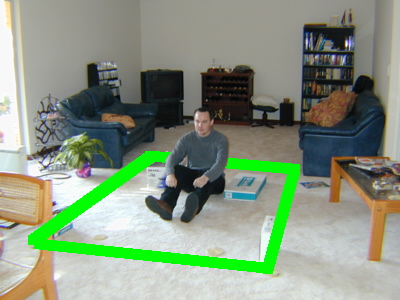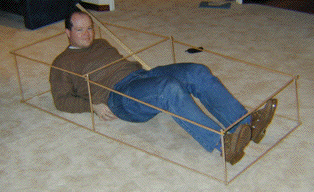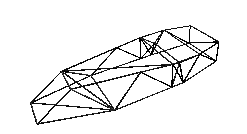News & Information
Membership
Contact Us
Sponsorship
Internet
Cafe
Gallery
People
Project
How to
Links
Chassis
As safety is the primary concern of the Sungroper team, the chassis was designed around a roll cage whose purpose is to protect the driver in the event of a collision, whilst still allowing them to escape the car quickly in the event of an electrical fire or other incident.
Of course, the chassis also provides the attachment points for the suspension, steering, solar array and exterior shell, and supports the weight of the batteries. The chassis needs to be rigid enough to withstand the stresses of driving, (braking, crosswinds, running off the road, cattle grids, etc), and yet as light as possible. It may also be necessary to repair the chassis during the race, so any materials used must be easily repairable on site.
To allow for a 'proof of concept', the plan was to build an electric vehicle which could be driven around without a solar array (ie only under battery power). Once this was refined and proved viable the solar panel array could be added. This would preclude us from purchasing an expensive solar array only to find out that the car it was being fitted to wouldn't be suitable for the race!
First, there came the coaster car. This gave us an idea of how much space the final car body would occupy, with respect to the size of a driver.
Pete and Craig made a mock up of the roll cage design to see how the driver would sit inside the roll cage, which would then be effectively mounted inside the chassis.
Then there was the side profile. This gave an idea of how the driver would be installed in the car and how the solar panel array would connect with the rest of the body.
![]()
Eventually the chassis design was changed to a space frame design to help ensure rigidity whilst still protecting the driver and minimising excess weight
(Click the image to download the 3DMF model file)Solar cars have a variety of construction techniques for their chassis. Some of the more sophisticated cars use a monocoque design where the external body and interal bracing of the vehicle forms the structural integrity of the vehicle. Other cars use more conventional chassis construction using materials such as stainless steel, chrome moly steel, aluminium and in some cases mild steel. Our rough pricing indicated that aluminium, stainless steel and chrome moly steel were all much harder to work with and 20 times as expensive as mild steel. The mild steel chassis would be more inclined to bend than crack which is what each of the other candidates would do under certain conditions. The mild steel chassis would also be easy to fix on the road if repairs were required. Working on the principle that if it came to it we could always use our mild steel chassis as a template to give to someone who could build us a lighter one out of aluminium off we went to build a mild steel chassis.
The chassis when complete including the main driver compartment, mounting points for suspension, the rear swing arm and the rear half of the car to support the solar array weighs approximately 38kg. The rear half of the car weighs approximately 12kg. Typical weights for light weight chassis' designed by professionals was 10-15kg. So if we decide to invest a couple of thousand dollars to have an aluminium chassis built we can potentially save 30kg.
The chassis member thicknesses were calculated by applying the likely forces generated by trying to stop the vehicle at 1G using just one front wheel. These forces were run through the structure to calculate the maximum load on any of the members around the suspension. Once we had these loads and the lengths of the members we calculated the deflection that would be generated and chose a thickness that gave us a deflection of less than 1mm. All of these calculations have lead to massive overengineering (probably). This is a by product of not knowing exactly what we can get away with and a desire to ensure the car is safe for the driver.





